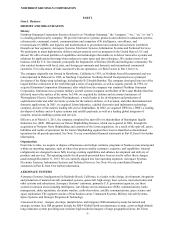Northrop Grumman 2013 Annual Report Download - page 19
Download and view the complete annual report
Please find page 19 of the 2013 Northrop Grumman annual report below. You can navigate through the pages in the report by either clicking on the pages listed below, or by using the keyword search tool below to find specific information within the annual report.NORTHROP GRUMMAN CORPORATION
-9-
under such programs may be terminated or adjusted by the U.S. Government or the prime contractor, which could
have a material adverse effect on our financial position, results of operations and/or cash flows.
Part I of the Budget Control Act of 2011 (Budget Control Act) provided for a reduction in planned defense budgets
of at least $487 billion over a ten year period. Part II mandated substantial additional reductions through a process
known as "sequestration," which took effect March 1, 2013, and resulted in approximately $40 billion of additional
reductions to the FY 2013 defense budget.
In March 2013, the President signed into law the Consolidated and Further Continuing Appropriations Act (2013)
which included specific appropriations for our major federal customers, including the DoD, subject to further
reductions or sequestration under the Budget Control Act.
In October 2013, Congress passed a continuing resolution to fund the government through January 15, 2014
(subsequently extended through January 18, 2014), and suspended the statutory limit on the amount of permissible
federal debt (the debt ceiling) through February 7, 2014.
In December 2013, Congress passed the National Defense Authorization Act (NDAA) for FY 2014. Congress also
passed, and the President signed into law, the Bipartisan Budget Act of 2013, which set discretionary spending levels
for FY 2014 and FY 2015. The legislation provides for additional budget funding of approximately $63 billion over
FY 2014 and FY 2015. The additional funding is expected to alleviate some budget cuts that would otherwise have
been instituted through sequestration in FY 2014 and FY 2015, with approximately $45 billion (generally split
equally between defense and non-defense spending) applied to FY 2014.
On January 16, 2014, Congress passed the Consolidated Appropriations Act of 2014, providing for federal spending
levels consistent with the Bipartisan Budget Act of 2013. The President signed the legislation into law on January
17, 2014. The discretionary spending levels for FY 2014 total approximately $1.1 trillion, of which the defense
spending level is $572 billion, comprised of $487 billion in base defense and $85 billion in overseas contingency
operations (OCO) funds.
The President's budget request for FY 2015 is currently due to Congress in February 2014. Congressional
appropriation and authorization of spending for FY 2015 and beyond, including defense spending, and the
application of sequestration remain marked by significant debate and an uncertain schedule. Congress and the
Administration also continue to debate the debt ceiling, among other fiscal issues, as they negotiate plans for long-
term national fiscal policy. The outcome of these debates could have a significant impact on defense spending
broadly and the company's programs in particular.
If the existing debt ceiling is not raised, we may be required to continue to perform for some period of time on
certain of our U.S. Government contracts even if the U.S. Government is unable to make timely payments. A debt
ceiling breach could, among other impacts, have significant near and long-term consequences for our company, our
employees, our suppliers and the defense industry. It could negatively affect the U.S. Government's timely payment
of our billings, result in delayed cash collections and have a material adverse effect on our financial position, results
of operations and/or cash flows.
The budget environment, including sequestration as currently mandated, remain a significant long-term risk.
Considerable uncertainty exists regarding how future budget and program decisions will unfold and what challenges
budget reductions will present for the defense industry. We believe continued budget pressures will have serious
negative consequences for the security of our country, the defense industrial base, including Northrop Grumman,
and the customers, employees, suppliers, investors, and communities that rely on companies in the defense industrial
base. Although it is difficult to determine specific impacts, we expect that over the longer term, the budget
environment may result in lower awards, revenues, profits and cash flows from our U.S. Government contracts.
Members of Congress continue to discuss various options to address sequestration in future budget planning, but we
cannot predict the outcome of these efforts. It is likely budget and program decisions made in this environment will
have long-term impacts on our company and the entire defense industry.
Long term funding for certain programs in which we participate may be reduced, delayed or cancelled. In addition,
budget cuts could adversely affect the viability of our subcontractors and suppliers, and our employee base. While
we believe that our business is well-positioned in areas that the Department of Defense (DoD) has indicated are
areas of focus for future defense spending, the long-term impact of the Budget Control Act, other defense spending
cuts, and the ongoing fiscal debates remain uncertain and our business and industry could be materially adversely
affected.
























